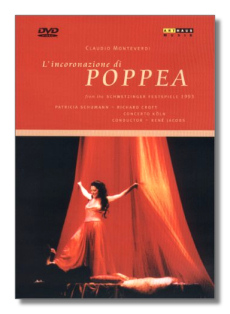
The Internet's Premier Classical Music Source
Related Links
- Monteverdi Reviews
- Latest Reviews
- More Reviews
-
By Composer
-
Collections
DVD & Blu-ray
Books
Concert Reviews
Articles/Interviews
Software
Audio
Search Amazon
Recommended Links
Site News
 DVD Review
DVD Review
Claudio Monteverdi

L'incoronazione di Poppea
- Patricia Schumann (Poppea)
- Richard Croft (Nerone)
- Kathleen Kuhlmann (Ottavia)
- Harry Peters (Seneca)
- Jeffrey Gall (Ottone)
- Curtis Ryam (Arnalta)
- Etsuko Kanoh (Page)
- Darla Brooks (Drusilla)
- Dominique Visse (Nurse)
Concerto Köln/René Jacobs
Arthaus Musik DVD 100109 150m LPCM Stereo Anamorphic Widescreen
What lessons are we taught by Monteverdi's L'incoronazione di Poppea (The Coronation of Poppea)? In short: evil triumphs. Nero's wife Octavia is banished in favor of his mistress Poppea, the philosopher Seneca is made to kill himself, and the adulterous Poppea gets a crown for her horizontal efforts with Nero. Why is this opera so delightful? Is it in spite of its moral inversion, or because of it?
This production comes from the 1993 Schwetzinger Festspiele where it appears to have been filmed without an audience present. (There is no applause and no coughing.) The sets are simple but imaginative. Much of the action takes place on what looks like the top of a zodiacal globe. Poppea's bed wheels in and out, and the flats move aside in some scenes to reveal, for example, a foggy Roman seascape, more suggested by color and light than by detail. Little attempt is made to convey a particular historical era through costuming. Instead, the costumes reveal the psychological traits of the characters. (In the case of Poppea, her costume is "revealing" indeed. This DVD might be a great way to introduce teenage boys to the glory of Monteverdi!) The staging eschews classicism, and links the opera to "Caligula," "I, Claudius," and other tarted-up sagas from the Roman era. There's nothing static about this opera, particularly not the way that it has been produced here. These are human characters with very human tastes, and this production hides little beneath a veil of propriety.
The performing edition used here is by conductor René Jacobs. Note that, for the purposes of this production, he has cut Monteverdi's lengthy score; chunks of music, even whole scenes, are missing. (The allegorical Prologue, repeatedly mentioned in the printed annotations, is one of the casualties.) The instrumental ensemble he has assembled – the scores that have come down to us do not indicate instrumentation – consists of three violins, two violas, two cellos, two cembalos, two lutes, harp, two flutes, dulzian, and two cornets.
A successful production of Poppea depends not upon operatic voices but upon singing actors who can color their voices and make drama out of the expressive melismas and coloratura. There are no seriously weak links in the cast. As Poppea, soprano Patricia Schumann is suitably alluring, and tenor Brian Croft's Nero retains something of the impetuous, spoiled boy about him. (Some editions of the score assign this role to a mezzo-soprano.) Jeffrey Gall, a counter-tenor Ottone, is unaccountably missing from the cast list in much of Arthaus's materials, but he is moving in the role of Poppea's spurned lover. Mezzo-soprano Kathleen Kuhlmann is regal and tragic like a raven as Nero's wife Ottavia. Despite weak low notes, bass Harry Peeters's Seneca commands attention, particularly in his death scene. Each time they appear, the two "drag" nurses, Curtis Ryam and Dominique Visse, steal their respective scenes. Ryam's Arnalta is clearly a direct ancestor of Mammy from "Gone With the Wind", and his appearance near the end of the opera as a lady of quality (now that Poppea's power is assured) is worth the price of this DVD. Drusilla, the wholesome maiden who loves Ottone, adds needed sunshine to the female side of the cast-list.
The quality of the DVD is high; images are clear and the sound is open and well balanced. The usual options are offered, including subtitles in a variety of languages. The accompanying booklet is not so good. It contains many typographical errors, and its author does not realize that the production preserved here is a slightly abridged one. This is just a small problem in a product that is almost uniformly excellent, but it has been a consistent one for Arthaus Musik. Perhaps the success of these DVDs will make it possible for them to pay more attention to annotations.
Copyright © 2001, Raymond Tuttle


















